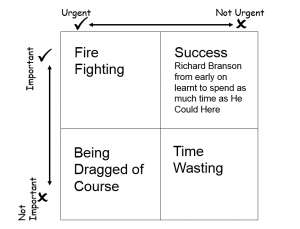The Clinic Coach : Time Management Part 2
After all, as The Clinic Coach say’s you can’t store time. Everyone has all the time there is. Nobody has more time than you in a day. Increased demand does not mean increased supply. And it’s not flexible (ignoring Einstein’s Theory of Relativity, for a while at least). What it’s actually all about is self-management, and you’ll have particular challenges depending on your circumstances and what you allow to distract you.
It might be that you procrastinate or avoid doing certain jobs – we all have distractions that can all-too-easily interfere with our day – but we simply need to make sure that we’re in control. When you look, you might even notice certain emotional triggers that lead you astray, and running a clinic can sometimes feel completely overwhelming.
The trick is to break these tasks down into manageable chunks. In the book The Happiness Advantage by Shaun Achor he talks about Zorro circles. The story goes that when Zorro first set out to change the world, he wanted to do too much, too soon, and was overwhelmed by the tasks that faced him, sinking into depression and drinking. Then, our hero met Don Diego who decided to train Zorro. Don Diego drew a small circle in the sand and told Zorro to step into it. Only when he’d mastered that small circle would he draw a bigger circle that he could then learn to master, and slowly the circles got bigger and bigger.
Shaun talked about how we are all ‘emotionally highjacked’ when we feel stressed or overwhelmed, and that we need to focus on the small things we can do, because as we take these baby steps, we instantly feel more in control, and – as a consequence – happier.
“Less Stress is Always Good” Clinic Coach
It’s a bit like asking ‘how do you eat an elephant’ or deal with any large project? The answer? One bite at a time! Simply cut it up into smaller pieces, prioritise the actions to be taken, and then create an action list and you’ll slowly move forward until the elephant is gone and you’ve achieved your goal.
Are You Addicted to Urgency?

This chart comes from Stephen Covey’s book The Seven Habits of Successful People, but Covey actually learnt the principles of this from Dwight D. Eisenhower’s Decision Matrix, something that Eisenhower used through his life as a General then President. He’s even quoted as saying. “What is important is seldom urgent, and what is urgent is seldom important.”
So looking at this chart, how much of what you do is in the ideal box of not urgent but important? That’s success. The planning and information work which is essential for building your clinic. It’s okay to cross over to the urgent and important box sometimes: clients may need prompt help, situations you can’t plan for may occur, or on occasion you may need to change your plans at the last minute. But many clinical staff and owners actually spend too much of their day dealing with urgent but not important tasks like emails and some calls, or even worse, you may get some team members slipping into the time wasting activities like chatting by the water cooler or random social media activities that have no strategy behind them so are not driving the business forward.
Ultimately, one thing you do have to get good at is planning – that’s the important but not urgent stuff – and this is where all the super-successful spend the majority of their time. You need a daily, weekly, monthly, and yearly action list and it will soon become a habit. It’s something that you need to get your team involved with too, so that they understand what’s important and why you’re doing it. I always advise that you host a weekly meeting and then a once a month overview of how the strategies that you’re employing are working and where you are as a clinic.
“Understanding Where Your Time Goes is Essential” Clinic Coach
Depending on the size and type of clinic you’re running, simply tracking what your team are spending their time doing can be critical. You may be using one of the industry-specific project management tools or even a paper based one, but if you’ve not really started tracking exactly where your clinics time is being spent yet, start now. There’s a very simple project management and time tracking tool called Toggl that will allow you to track what your team are doing and for whom they’re doing it, so it’s worth an explore.
If you’re looking to increase efficiency, though, where should you begin? It all starts with a routine, and getting you and your team to block out your day so that you focus on whatever it is that you need to be doing with no distractions. Schedule to pick up and respond to your emails just twice a day – perhaps from 10am till 11am, and 3pm till 4pm, then set aside some more time to return calls – you may wish to do this once a day but limit it to a maximum of three a day regardless. Then block out the rest of the stuff you need to do around this.
“Write Out Your Perfect Week” Clinic Coach
Take some time out to write out your perfect week and get your team to do theirs as well. A guide and template for this is included the pack of free bonuses I’ve put together for you at www.TheBeautifulBusinessBook.com.
You may be thinking ‘I can’t do that, my clients expect to be able to get hold of me’ but just consider for a moment that unless you’re a member of the emergency services or urgent response, it’s highly unlikely that it’s a genuine life or death situation. Plus, if your customers expect instant feedback, stop for a moment and ask yourself who’s trained them to think that way…
“Emails Aren’t So Important That They Take You Away From What Is Important” Clinic Coach
Has anyone ever emailed you to say ‘the building’s on fire’? And how many issues need you to instantly respond on the phone? As long as you revert back to the client on the same day, or even within a few hours, it shouldn’t be a problem. If it is, then set up an emergency email or have a dedicated line or mobile to deal with pressing issues (and if you can charge a premium rate for providing this, then make sure you do as it will make people think twice about using it).
“Do This Every Time” Clinic Coach
And, with every email you receive, make sure that you deal with it as you read it the first time. Ask yourself the following questions and take these actions:
1. Does it concern you? If not, pass it on
2. Do you need to keep it? If not, bin it
3. Is it useful? Yes, file or read it, no, bin it
4. Does it need action? Yes, do it, and no, file it or pass it on.
Create a routine, set up files and systems for easy retrieval, and learn to scan and speed read emails and messages.
By Alan Adams The Clinic Coach




